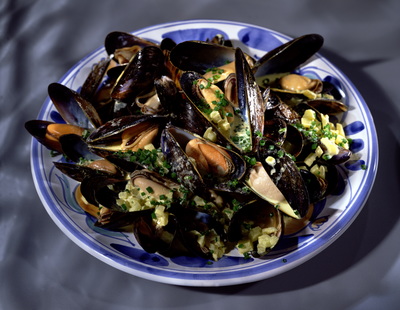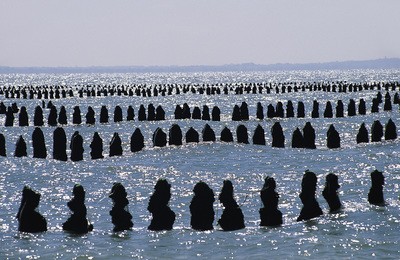Photos courtsey of Robert Harding Images Mussels, oysters and shellfish science nibbles
The carbon sequestered in the shells of the mussels harvested amounts to 218 kg CO2-eq per tonne of mussels harvested and for oysters, the equivalent figure is 441 kg CO2-eq per tonne of oysters harvested. Based on the various assumptions, the cradle to grave carbon footprint is calculated to be 649 kg CO2-eq per tonne of mussels harvested and 1,685 kg CO2-eq per tonne of oysters harvested. This does not consider any carbon sequestered. Including carbon sequestration in the harvested shellfish, the cradle to grave carbon footprint is calculated to be 430 kg CO2-eq per tonne of mussels harvested (418 if including carbon sequestered in mussels dying at sea and sinking to the seabed) and 1,244 kg CO2-eq per tonne of oysters harvested. Under carbon sequestration, currently only afforestation and reforestation are considered additional activities under the Kyoto Protocol. This means that, at present, shellfish farming projects would not be eligible for carbon credits. At a future Conference of the Parties to the Kyoto Protocol, this could potentially be expanded with research and sound arguments to include aquaculture projects. These would then need to demonstrate additionality to be eligible. Additionality means that the project must provide emission reductions that are additional to those which would have occurred under a business-as-usual scenario. The data suggest that shellfish perform favourably against meat products and that mussels specifically can justifiably be promoted as a low-carbon food product. Jonna Fry, Carbon Footprint Of Scottish Suspended Mussels & Intertidal Oysters by Environment Resources Management for the Scottish Aquaculture Research Forum, published Jan 2012. “Mussel farming is simple, flexible, cost effective and straight forward concept for improving coastal water quality. At the same time it is a sustainable production of valuable seafood and provides coastal jobs. The use of mussel farming to combat eutrophication has large potential and may become a new commodity on a global scale.” ODD Lindahl & Sven Kollberg, Sven Loven Research Centre, Sweden 2008 |
As the global average temperature increases and CO2 within the ocean begins to reach saturation the ability of the ocean to absorb carbon will alter significantly, at some point in the future removing carbon from the ocean may need to be considered. One method for achieving the removal of carbon from the ocean would be through the ancient practice of shellfish farming. Using ‘plate’ oyster stocking density, shellfish sequestration was competitive with some plant species such as Eucalyptus porosa, but was eclipsed by other species such as Eucalyptus socialis. The Carbon content of an oyster shell can be derived from the overall mass of the oyster. One dozen oysters weighs on average 1 kilogram (kg). Subtracting meat weight from the total oyster weight gives an approximate shell weight of 69.83g. The shell consists of the chemical compound Calcium Carbonate (CaCO3) as stated above. Using the atomic weight of the elements within this compound the amount of carbon within the shell can be calculated. Calcium (Ca) has an atomic weight of 40g; Carbon (C), 12g; and Oxygen (O), 16g (Serway, 1996). Therefore the overall molecular weight of CaCO3 is: 40+12+(3X16)=40+12+48=100g Therefore Carbon contributes 12g for every 100g of shell, or 12% of overall shell mass. Taking the ‘spat’ stocking density as the starting point it can be seen that an oyster farm as a whole does sequester a large amount of carbon per year but this does not necessarily equate to a per hectare figure. An independent assessment of the shellfish industry would be required to determine the extent of carbon sequestration and the overall costs of generating carbon offsets through this method. The oyster industry is well established in South Australia and the establishment of shellfish as a carbon sink could be of great benefit to South Australia. Qualifying as an ‘additional’ activity under the Kyoto Protocol may prove difficult for the oyster industry, especially as it is self-sufficient and not reliant on funding from carbon offsets The main advantage of oyster farming is that unlike other ocean sequestration techniques, the oyster shell permanently removes carbon from the ocean as well as the atmosphere. This aspect will become more important as global warming and ocean carbon capacity affect the amount of carbon absorbed by oceans An independent assessment of the shellfish industry would be required to determine the extent of carbon sequestration and the overall costs of generating carbon offsets through this method. After additionality, the carbon price tag will ascertain whether shellfish sequestration is a viable option in the struggle against global warming. Regardless of anthropogenic policy making, however, shellfish will continue to play their role in mitigating the greenhouse effect Carbon Sequestration Potential of Shellfish, 2009, J. P. Hickey, School of Natural and Built Environs, University of South Australia. - See more at: http://www.thefishsite.com/articles/615/carbon-sequestration-potential-of-shellfish/#sthash.K6qMAeRE.dpuf |









